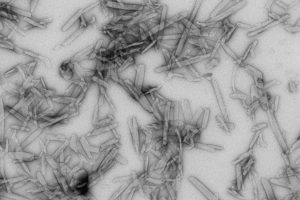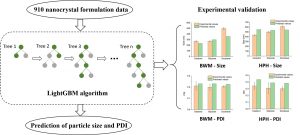A research team of the Institute of Chinese Medical Sciences (ICMS) of the University of Macau (UM) has developed machine learning algorithms based on big data to predict and assist in the development of nanocrystals for nanopharmaceutical preparations. The algorithms developed by the team can achieve a fairly high degree of prediction accuracy for nanocrystals prepared with the ‘top-down’ method. The study is of great significance for rational formulation design and can potentially reduce research and development time in the industrialisation of nanocrystals. The related article has been published in the well-known Journal of Controlled Release.
Currently, about 40 per cent of drug candidates in the development pipelines are poorly water-soluble drugs. Because of this property, it is difficult for these drugs to achieve an ideal degree of bioavailability and treatment efficiency with traditional formulation strategies. It has been reported that nanocrystals could improve the bioavailability of these drugs. However, the current preparation of nanocrystal formulations is highly dependent on the experience of experts and a process of trial and error that is time- and resource-consuming with a high risk of failure. In recent years, machine learning technology based on big data has shown great potential in many fields, such as network optimisation, information management, biomedicine and materials science. It can quickly find the internal relationship between existing data and can be applied to the prediction of unknown data. Based on these advantages, UM researchers extracted 910 in-house nanocrystal data from Dr Ying Zheng’s laboratory and published articles indexed by the Web of Science, used machine learning algorithms to find the internal rules, and finally predicted the particle size and polydispersity index (PDI) of newly prepared nanocrystals under different preparation methods. The results have confirmed that the machine learning models established by the team have a fairly high degree of prediction accuracy for nanocrystals prepared with the ‘top-down’ method. The study is of great significance for rational formulation design and can potentially reduce research and development time in the industrialisation of nanocrystals.
The Journal of Controlled Release is a well-known academic journal in the field of pharmaceutical preparations, with an impact factor of 7.901 in 2018. UM Assistant Professor Ouyang Defang and Full Professor Zheng Ying are the corresponding authors of the research article. UM doctoral students He Yuan and Yezhu Yifan are the co-first authors. The following individuals have also made important contributions to the study. They are UM Research Assistant Liu Xinyang, master’s students Wei Zhengjie and Qiu Fen, and Dr Li Haifeng of Institute of Applied Physics and Materials Engineering. The study was supported by the Macao Science and Technology Development Fund and UM.
Source: Institute of Chinese Medical Sciences
Media Contact Information: Communications Office, University of Macau
Albee Lei Tel:(853) 88228004Kelvin U Tel:(853) 88224322Email:prs.media@um.edu.moUM Website:www.um.edu.mo


